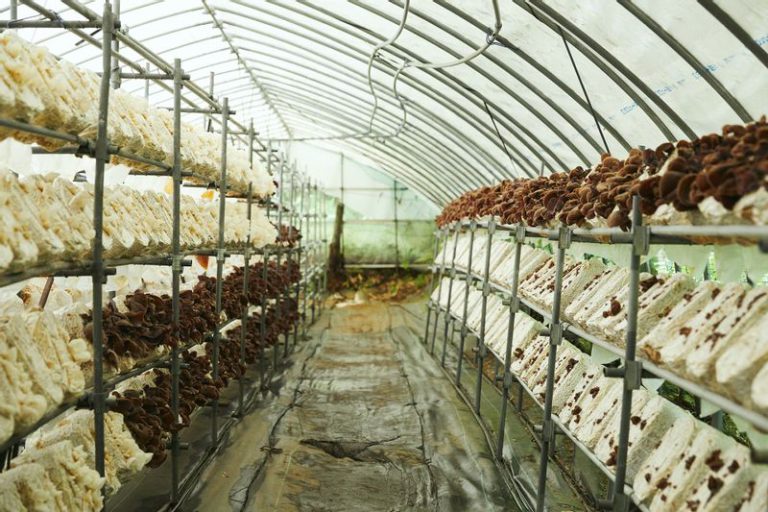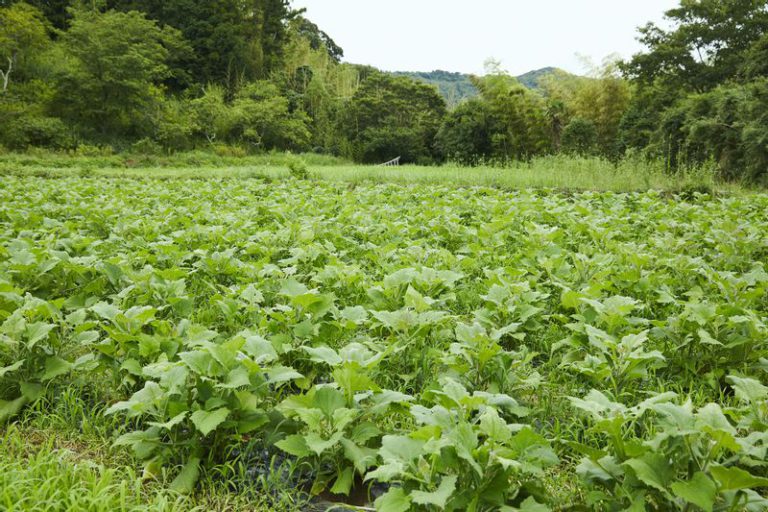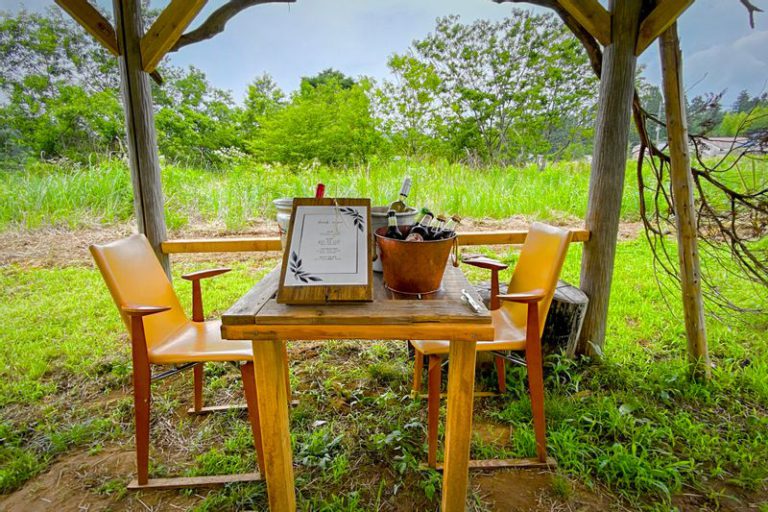Fresh Wood Ear: A Summer Flavor Nurtured by Seiwa’s Spring Water

Wood ear sashimi has changed the wood ear's image

First, please look at the photo. Have you ever seen wood ears so large and well-formed with a beautiful, velvety texture? They are thick and gelatinous, are crunchy when chewed, and slide down the throat smoothly. Restaurants in Boso serve them as wood ear sashimi, simply blanched in boiling water so that customers can enjoy their delicate texture.
Wood ear, a familiar Chinese ingredient available in Japan, is mostly imported dried from China. Since ancient times, it has been valued in China in its philosophy that food is a form of medicine. In recent years, it has received attention as a health food containing abundant soluble fiber, three times the iron in liver, twice the calcium in cow’s milk, and an outstanding vitamin D content.
The word “kinkatsu” (microbial activity) was coined about 10 years ago to encourage people to get in shape by eating fungi, including fermented foods, and mushrooms also attracted attention. It is said that the movement to grow wood ear, which was mostly imported, in Japan spread. Even so, domestically-grown fresh wood ear only accounts for 5% of that distributed in Japan. Furuki explains how he came to grow wood ear in Kimitsu.

“When I moved to Seiwa in Kimitsu and thought about what I could grow suited to the land without competing with existing farmers, wood ear came to mind. Wood ear is about 90% water. This area has an agricultural water supply that local farms have been protecting for 50 years. Wood ears fed with plenty of water filtered through the mountains of Seiwa are different from those raised on tap water. We also grow them large and thick by paying attention to the temperature and humidity,” says Furuki.
We immediately went to see the greenhouse that produces the exquisite wood ears, guided by Furuki.
Each wood ear is well-maintained

Higashihikasa, Kimitsu, is nestled in the mountains in the center of the Boso Peninsula, and the temperature is about two degrees Celsius cooler than the city. Furuki built his wood ear greenhouse to avoid direct sunlight, as the village is protected by a bamboo grove on the south side.
Wood ear is a mushroom commonly found in natural forests, and the type cultivated as a crop is called cloud ear fungus. Cultivation begins with the preparation of the mushroom bed. After sterilizing a plastic bag filled with sawdust, rice bran, wheat bran and rice husk, wood ear spores are stirred in and rested for about three months. The surface is eventually covered with pure white spores. The mushroom bed is complete.

When the work of “fruiting” is done by cutting open the bag of the substrate, wood ears begin to mushroom. It takes about three to four weeks from fruiting to harvest and requires daily watering.
“Controlling the water content is everything to improving the texture. Wood ear dries out when it’s sunny and becomes soggy when there is a heavy downpour. I came to understand when wood ears are thirsty for water because I’m looking after them daily,” says Furuki.

Furuki says he visually checks every wood ear and separates any stuck together to prevent the mushrooms from crimpling and deforming. He says he cultivated about 1,200 beds until last year but had scaled down to 700 beds so that he can keep an eye on all of them.
Since wood ears do not fruit when the temperature drops below 18 degrees Celsius, they can be harvested from July to late October. Only ones that have grown to a massive 10 centimeters with tender loving care are shipped as the summer delicacy, “fresh wood ear to enjoy as sashimi.” Furuki says he cannot fulfill all orders this year as he has sold out by home delivery orders alone.
Practicing "living with a satoyama that breeds and connects"

Furuki has developed wood ear as a fine flagship product, but he is not limited to just this product. He has gradually expanded the farmland he leases to grow rare vegetable species such as yacón, velvet bean, wild rice and herbs without pesticides or fertilizers.
“Yacón is a folk remedy used for diabetes in the Andes in South America. Through trial and error, I’ve developed a delicious tea with the discarded leaves. Its delicate sweetness comes from fructooligosaccharide, and it increases the bifidobacteria in the intestines. Velvet bean contains the ingredients of drugs for treating Parkinson’s disease,” enthuses Furuki.

When asked out of the blue what he specialized in before farming, Furuki says he had studied microbes at graduate school and was a technician who had obtained many patents at a pharmaceutical manufacturer. He joined the Japan Overseas Cooperation Volunteers in his 20s, lived a total of 10 years in Costa Rica, and was also involved in a fermented foods business.
He moved to Kimitsu after returning to Japan in 2012. Besides the farm, he has a fermentation lab, his specialty, where he is engaged in a range of endeavors. They include research and development of functional foods such as soy tempeh, processed goods such as dried foods using a reduced-pressure dryer, aromatic distilled herbal water and bokashi (a type of natural fertilizer) made with homemade lactic acid.

Furuki says, “When I saw people in the world enjoying a good life even when they were poor, I thought the Japanese also needed it in the truest sense, so I moved to Kimitsu because I wanted to engage in business that connects cities with rural life. I want people to come to Kimitsu on weekends to experience communing with nature and life where resources are recycled.” With friends, he operates the Aozorabatake no Daidokoro, a restaurant run by a chef in the middle of an eco-farm, and a guesthouse and event space, Maripo no Ie.

The word maripo in maripo.commu comes from mariposa, the Spanish word for butterfly. The name is charged with Furuki’s wish for the world to change for the better by making small changes, like the fluttering wings of butterflies.
Furuki’s high-quality fresh wood ear has been recognized as a Kimitsu specialty and selected as a furusato nozei (hometown tax donation) return gift. Irregular wood ears are dried under reduced pressure and sold as Kikurage Powder, a seasoning that can be enjoyed without losing umami or nutrients. Maripo Farm aims for 100% circular agriculture by making its best efforts to eliminate waste. Furuki taught us delicious ways of enjoying fresh wood ears.
Fresh wood ear recipe recommendations

The first thing to try is fresh wood ear sashimi. It is quite simple to make.
Trim the fresh wood ear stems, blanch them in boiling water for 30 seconds, and cool them in cold water. Slice them into bite-size pieces, and enjoy them with your favorite sauce, such as wasabi soy sauce, mustard soy sauce and ponzu.

Next is a Chinese-style salad of fresh wood ears and summer vegetables. Combine lightly blanched and cooled wood ears with julienned cucumbers and tomatoes, and season them with natural salt and toasted sesame oil. Add a few drops of oyster sauce as the secret ingredient to give richness to the flavor.
As a main dish, try Chinese stir-fry of fresh wood ear and egg. Lightly fry the wood ear in toasted sesame oil and add a whisked egg. Add dashi made of oyster sauce, sake and chicken stock and season with salt and pepper to taste.
Tempura is another recommendation. With tempura, it is safer to pierce the wood ears with a toothpick before dipping them in the batter for frying to stop them from puffing up.
Enjoy the flavor unique to fresh wood ear fully by cooking it in various ways.
Kimitsu's fresh wood ears
Source:Shinya Furuki, maripo.commuPeak Season
July to September
Tips
・Thick and large
・Velvety and shiny
・Soft
How to enjoy them
Lightly blanched sashimi, salads and stir-fries.






